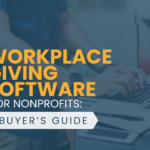Workplace Giving Trends: Current Happenings & Expectations


Workplace giving isn’t just about writing checks; it’s a strategic type of partnership between businesses and nonprofits to transform communities. Fortunately, the world of workplace giving is ripe with opportunities for organizations to join forces and address societal challenges with creativity and determination. In fact, the coming year promises innovative workplace giving trends that can benefit both nonprofit fundraisers seeking support and corporations eager to make a meaningful societal impact.
This is especially true considering corporate giving increased by approximately 3.4% last year, totaling $29.48 billion.
As we delve into the CSR trends shaping the nonprofit sector, we’ll explore why these developments are relevant to nonprofits and companies alike. No matter which side of these relationships you’re on, there’s something useful to learn. Here’s what we’ll cover:
- 8 Workplace Giving Trends Worth Paying Attention To
- What These Workplace Giving Trends Mean For Nonprofits
- Inspiring Examples: Workplace Giving Trends In Action
- How to Tap Into These Workplace Giving Trends
Knowing about emerging corporate philanthropy trends empowers companies to develop meaningful CSR programs and nonprofits to tap into those opportunities. If you’re ready to explore the growing power of CSR, let’s dive into the latest trends in corporate giving.
8 Workplace Giving Trends Worth Paying Attention To
Companies constantly change and expand their corporate giving initiatives. With these developments come patterns that impact the philanthropic landscape. Staying updated on corporate giving trends ensures that both companies and nonprofits are impactful in their philanthropic endeavors.
Companies and nonprofits that align their efforts with these trends can more effectively leverage their resources and plan initiatives, increasing the likelihood of success. Let’s take a look at eight top corporate philanthropy trends you’ll want to know.
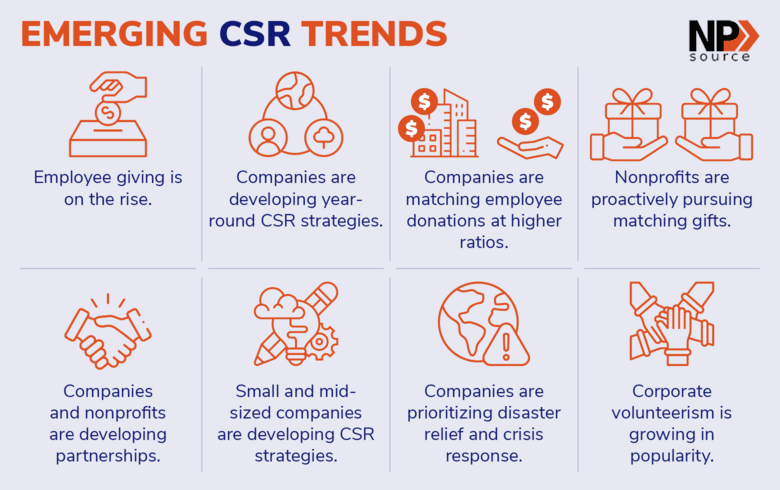
1. Employee Giving Is On The Rise.
Workplace giving is an incredibly impactful way that companies bring employees in on their philanthropic initiatives. As explained in Double the Donation’s workplace giving guide, “workplace giving is an umbrella term, which means it can refer to multiple types of programs. When [provided] multiple ways to get involved, employees have the freedom to choose how they want to give.”
America’s Charities’ workplace giving statistics estimate that $5 billion is donated through workplace giving every year. What’s more, 39% of surveyed companies indicated plans to expand their workplace giving programs in the next two years. It’s not hard to see why, either!
Individuals want to make a difference, and their employers can play an impactful role in that. That’s why 71% of employees say it’s imperative that their employer supports giving and volunteering.
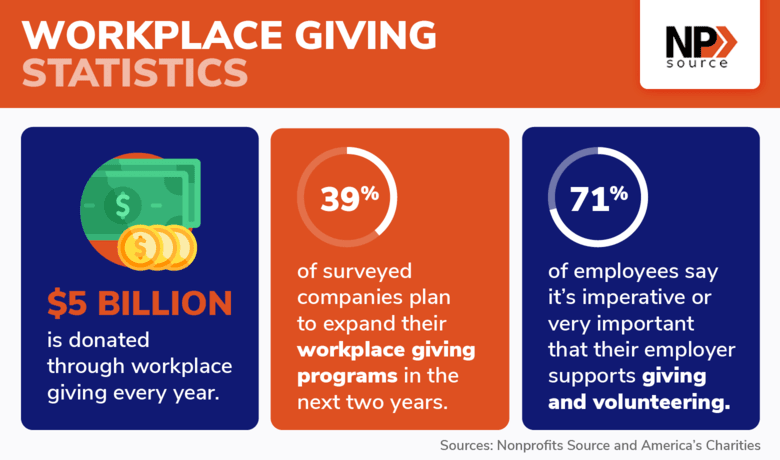 So, how are companies getting in on this trend? Here are some common types of workplace giving:
So, how are companies getting in on this trend? Here are some common types of workplace giving:
- Employee Donations: Employees can voluntarily contribute part of their salary to support charitable organizations, often through payroll deductions.
- Charitable Giving Stipends: Companies can award employees with gift cards or add funds designated for donating to their accounts within their employee giving portal. Employees can then donate this money to support the charity of their choice.
- Employer Matching Gifts: Companies offer to match employees’ charitable donations, effectively doubling the impact of their contributions.
Companies everywhere recognize the power these programs hold, so pay attention to employee giving as you craft your CSR strategy, regardless of whether you work for a nonprofit or company.
2. Corporations Are Developing Year-Round Workplace Giving Strategies.
In recent years, companies have shifted from one-off annual giving campaigns to year-round CSR programs. In fact, according to a survey conducted by The Conference Board ESG Center, 94% of major U.S. corporations plan to heighten or maintain their charitable giving in the next few years.
These companies have learned that engaging in corporate giving initiatives year-round leads to heightened employee engagement and a greater philanthropic impact.
Year-round CSR strategies enable companies to make an enduring difference in their communities and for the causes they support. Not to mention, consistent engagement with communities builds trusting relationships. Over time, companies become valued partners in addressing local issues, rather than occasional contributors.
That’s why more companies are turning to year-round strategies like corporate volunteer grants, matching gifts, fundraising matches, and corporate volunteering.
3. Companies Are Matching Employee Donations At Higher Ratios.
Businesses everywhere have noticed that they can make a bigger difference through their matching gift programs by simply matching at higher rates. Many companies have also increased the maximum donation amounts they will match. This is a great way to communicate they support the causes their employees care about!
Take Coca-Cola for example. They offer a generous 2:1 match ratio and will match donations up to $10,000 per employee per year. American Eagle Outfitters (which has upped its maximum match amount), The Hartford (which has doubled its existing match ratio), Chicago Community Trust (which has increased its donation limit and its match rate) are all great examples of this trend in workplace giving.
This increased generosity is good news for nonprofits! After all, 1 in 3 donors say they’d give a larger gift if they know it will be matched.
4. Nonprofits Are Proactively Pursuing Matching Gifts (& Other Forms of Workplace Giving).
Partially as a result of companies creating more generous employee giving programs, more nonprofits are pursuing matching gifts.
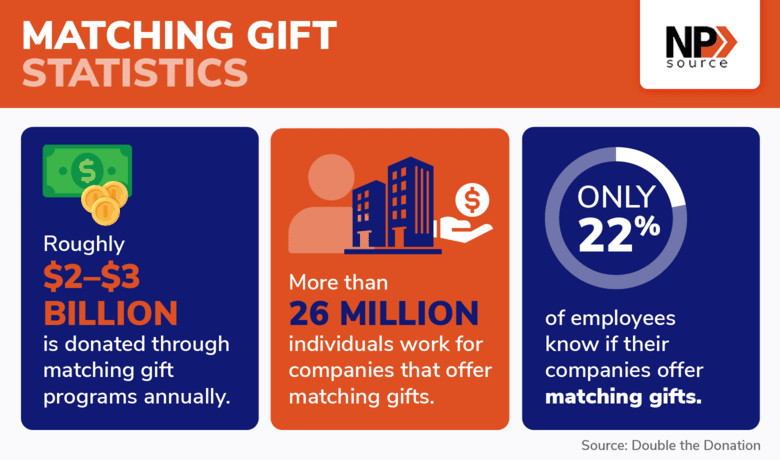
Roughly $2–$3 billion is donated through matching gift programs annually. While more than 26 million individuals work for companies that offer matching gifts, only 22% of this group knows if their companies offer this type of program (Source: Double the Donation’s Nonprofit Fundraising Statistics).
To ensure they receive every contribution possible, many nonprofits are proactively educating their staff and donors about corporate giving opportunities. To get in on the action, nonprofits can take the following steps:
- Conduct internal matching gift training. Ensure staff can answer donors’ questions about matching gifts.
- Integrate a matching gift search tool directly into the donation process. Donors can use the tool to research their employers’ match programs and determine their eligibility.
- Use matching gift software to locate eligible donors. Dedicated software enables you to follow up with match-eligible donors automatically.
If you work at a nonprofit, take the steps we shared above. If you work at a company, make sure your employees know about your program, so you can maximize participation and grow your impact.
5. Companies And Nonprofits Are Developing Closer Partnerships.
The corporate giving trend of partnerships between companies and nonprofits represents a shift in how both sectors approach social and environmental changes.
Corporate partnerships open the door to a solid connection and deeper understanding. Think about it this way: When a company doesn’t know about an organization or cause, it likely won’t write a check. With long-term partnerships, companies will be more receptive to continued funding proposals.
One recent innovation coming out of these tighter partnerships is matching gift auto-submission. This feature enables employees at companies like Checkr and Innovative Discovery to submit matching gift requests directly from their favorite nonprofits’ donation pages.
This feature reduces complications for nonprofits, companies, and donors alike, resulting in higher participation in workplace giving initiatives.

6. More Small and Mid-Sized Companies Are Developing Workplace Giving Strategies.
Corporate giving isn’t just for enterprise corporations! Small and mid-sized businesses are getting in on the action, too.
The trend of more small and mid-sized companies developing CSR strategies reflects the growing recognition of the importance of responsible business practices across industries. These businesses are embracing CSR as a means of meeting stakeholder expectations, driving positive social and environmental impact, and strengthening their competitive position in the market.
One of the easiest ways to get started is by developing a matching gifts program. This is a fairly low-maintenance way to support the causes your employees care about. After launching your program, all you need to do is approve their corporate match requests and distribute donations.
You can also engage employees in other workplace giving trends like payroll deductions or corporate volunteer opportunities.
7. Companies Are Prioritizing Disaster Relief and Crisis Response.
In a recent study, corporate giving efforts accounted for $405 million in contributions related to disaster relief. Companies recognize that society is increasingly passionate about these causes, and these businesses can play a major role in mitigating the impact of environmental crises.
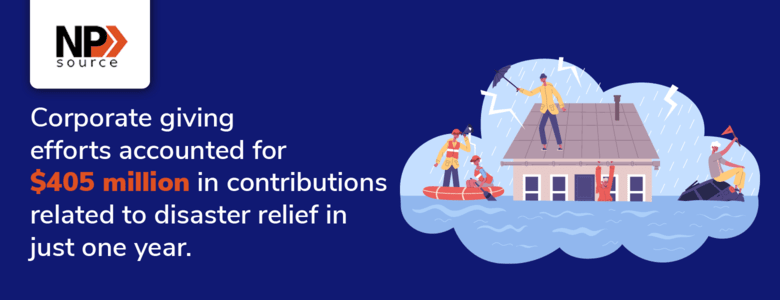 Essentially, companies are prioritizing this area to demonstrate their commitment to social and environmental stewardship, enhance their brand reputation, and fulfill their ethical and moral responsibilities in times of crisis.
Essentially, companies are prioritizing this area to demonstrate their commitment to social and environmental stewardship, enhance their brand reputation, and fulfill their ethical and moral responsibilities in times of crisis.
Some companies have taken actions such as pledging to match employee donations at higher rates to disaster relief causes, while others have developed entire giving initiatives related to disaster relief and crisis response.
8. Corporate Volunteerism Is Making Waves.
Businesses set up volunteer opportunities as a meaningful way to give back to society and strengthen workplace culture. There’s a good reason for this.
These days, employees are five times more engaged when their employer offers a volunteer program, according to volunteer management research from Galaxy Digital. What’s more, company-sponsored volunteer projects and other opportunities that encourage teamwork are the most common components of a company’s volunteer strategy by 71.43%.
To hop on this corporate philanthropy trend, 60% of companies offer employees paid time off for volunteering, according to that same Galaxy Digital resource. That means anyone who participates can volunteer at a nonprofit during work hours without giving up their paycheck.
Plenty of companies also offer volunteer grants to drive impact even further! With this initiative, companies donate to nonprofits where their employees regularly volunteer at an hourly rate. For example, a company might donate $25 for every hour an employee spends volunteering at a nonprofit.
What These Workplace Giving Trends Mean For Nonprofits
It’s no secret that corporate giving programs significantly impact charitable causes. For one, the CSR trends we’ve covered indicate where companies currently allocate their charitable resources. Understanding these trends empowers fundraisers to focus on areas with growing corporate interest, maximizing their chances of securing funding.
Let’s explore how nonprofits should adjust their strategies to leverage the latest corporate giving trends.
Prioritize Relationships with Corporations.
Remember, more companies are prioritizing long-term partnerships with nonprofits over one-time gifts. To form a new partnership, nonprofits should build relationships with these companies before soliciting support.
To get started, nonprofits can experiment with these tried-and-true strategies:
- Understand corporate priorities. Nonprofits should look for a natural fit in a corporate partner, either in mission or proximity. For example, grocery stores and food companies’ missions naturally align with food banks. Meanwhile, local businesses surrounding a school or church are great options due to their proximity.
- Connect with local business owners. While it’s tempting to target businesses with major assets like Fortune 500 companies, starting small with local businesses is likely to be more practical for most nonprofits. Remember, more small and mid-sized businesses are creating these programs, expanding nonprofits’ opportunities.
- Demonstrate mutual benefit. Explain how a partnership benefits both parties, creating a win-win scenario that is appealing to potential corporate partners. Two common benefits to share with potential partners include enhanced brand awareness and happier employees.
- Provide ongoing involvement opportunities. The partnership should be as easy as possible to maintain. Pitch programs that require minimal oversight like a year-round employee volunteer program or matching gift program.
By prioritizing relationships with companies, nonprofits can lay the foundation for more meaningful and sustainable support.
Ensure Flexibility in Giving Opportunities.
With the rise of workplace giving and corporate philanthropy in general, nonprofits should provide plenty of opportunities for companies and their employees to get involved. Here are a few ideas to get started:
- Workplace Giving: More than 49% of nonprofit respondents in an America’s Charities survey identified workplace giving as a growth strategy for their organizations. Workplace giving provides a chance to promote their mission, programs, and services while recruiting new supporters.
- Matching Grants: Nonprofits can look into matching grant programs, where a corporation agrees to match all donations made to a specific program or fundraiser. This encourages companies to offer support and share some of the financial risk for projects.
- Volunteer Programs: Not all corporate support has to be financial. As an extension of workplace giving, volunteer programs are an easy way for companies to grow their philanthropic impact. Nonprofits can line up volunteer days where the company’s employees work together at the organization.
Flexible giving opportunities help accommodate the evolving priorities and interests of corporate partners, ultimately strengthening these relationships and maximizing impact.
Encourage Donors to Advocate For Workplace Giving Programs.
If you work for a nonprofit, you know your supporters are your mission’s biggest advocates. Have them reach out to their employers to launch a corporate giving program.
For example, let’s say several donors work for the same company, but the company doesn’t offer a workplace giving program. That’s a good opportunity for the nonprofit to encourage them to chat with their company’s leaders about starting a matching gift program or enabling donations via payroll deductions.
At the very least, they can introduce your nonprofit’s fundraising team to their company’s leadership to start the conversation.
Inspiring Examples: Workplace Giving Trends In Action
As workplace giving programs continue to evolve, it’s a good idea to become familiar with leading examples of companies giving back to nonprofits across the globe. Not to mention, doing so allows you to see the above workplace giving trends in action!
Strong Corporate Volunteerism Programs
Another way CSR continues to grow is through corporate volunteerism. When companies encourage their employees to volunteer, they foster a culture of community involvement and social responsibility. This not only benefits the nonprofits receiving volunteer support but also enhances employee morale and job satisfaction.
A few standout examples include the following:
- Patagonia offers a generous VTO program in which any employee is encouraged to take up to 18 hours of paid time for volunteering each year. In addition, the company offers select two-month paid internship opportunities in which employees can volunteer with the environmental organizations of their choice.
- Warner Media supplies each employee with up to 40 hours (or one full, paid week off work) to spend volunteering with nonprofit causes on an annually recurring basis.
- Disney encourages employee volunteerism through its “EARS to You” grant program—also known as volunteer grants or dollars for doers.
Tons of companies offer unique and powerful employee volunteer incentives. And there’s a significant overlap between companies offering matching gifts and companies offering volunteer programs—which can make it eve easier to locate the best opportunities in your network.
Sometimes, the best way to learn about trends in corporate philanthropy is by looking at real-world examples! Let’s look at some generous programs that exemplify the CSR trends we’ve covered.
Reinstated Matching Gift Programs
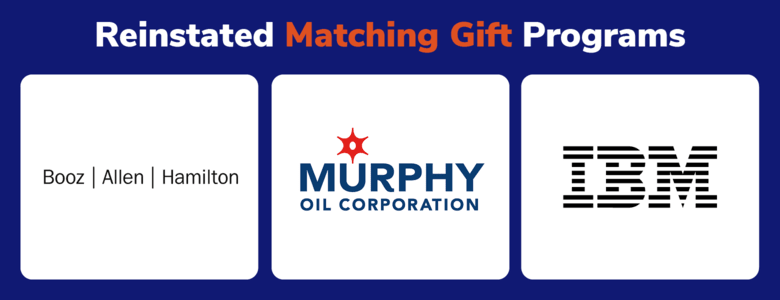
Matching gifts are the easiest, most powerful way for companies to make a positive philanthropic impact. According to Double the Donation’s CSR trend analysis, several companies suspended their employee matching gift programs at one time, but as of 2023, several companies have reinstated their initiatives, indicating a renewed commitment to CSR. A few of these companies include:
- Booz Allen Hamilton suspended its matching gift program in 2021 but officially reinstated it in January 2023. Both full-time and part-time employees are eligible, and the company will match donations from $25 to $500 at a 1:1 ratio.
- Murphy Oil previously reinstated its matching gift program and now offers a generous match for full-time and part-time employees’ donations between $25 and $2,500. Murphy Oil matches donations to educational institutions/organizations at a 2:1 ratio and donations to most nonprofits at a 1:1 ratio.
- While switching to a new system, International Business Machines (IBM) paused its match program. Now, the program has resumed, and employees are eligible to have donations matched up to $10,000.
These examples show that workplace giving and matching gifts in particular are gaining popularity. With so many generous opportunities available, it’s not hard to see why nonprofits and corporate employees are pursuing matching gifts.
Target’s Disaster Relief CSR Program
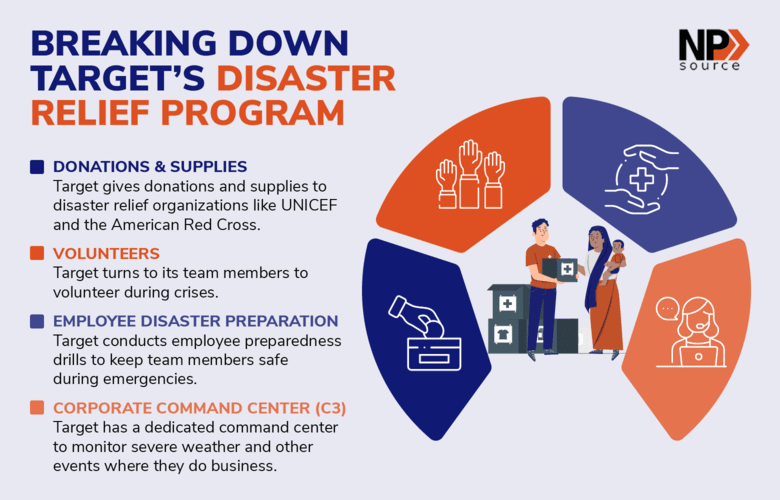 Globally-known company Target launched a disaster relief program to showcase its commitment to helping in times of crisis and humanitarian need. They recognize their global supply chain can move quickly, enabling them to be on the scene at disaster sites to provide supplies and volunteers.
Globally-known company Target launched a disaster relief program to showcase its commitment to helping in times of crisis and humanitarian need. They recognize their global supply chain can move quickly, enabling them to be on the scene at disaster sites to provide supplies and volunteers.
They work year-round to provide disaster relief organizations with donations and resources. Here are some recent examples of their efforts:
- Maui wildfires: In August 2023, Target donated $1 million to aid response and recovery efforts for one of the worst disasters Hawaii has ever experienced. The donation was distributed to disaster relief organizations like the American Red Cross, Hawaii Community Foundation, and local food banks.
- Turkey and Syria earthquake: In early 2023, a massive earthquake impacted Turkey and Syria. While Target doesn’t directly operate in either country, they committed $500,000 to immediate response and recovery efforts.
- Hurricane Ian: In response to Hurricane Ian, Target partnered with the American Red Cross, Team Rubicon, and local nonprofits to provide $5 million in disaster response efforts. Target stores across the region supported first responders and nonprofits in purchasing necessary supplies to help those impacted. What’s more, the company provided financial assistance by matching donations dollar-for-dollar up to $3 million in response to the hurricane.
These are just a few examples of how one big-name corporation is stepping up to help with disaster relief. The company even has a dedicated command center to monitor potential issues in locations where they do business. That way, they can quickly respond to almost any situation that could affect customers, team members, or their supply chain.
How to Tap Into These Corporate Philanthropy Trends
The easiest way to leverage the trends we’ve covered is to invest in the right software. Whether you fundraise for a nonprofit or lead CSR initiatives for a company, you can use dedicated technology to drive participation in corporate giving.
The Nonprofit Perspective
Matching gift technology is the best tool for nonprofits that want to leverage corporate philanthropy trends. This software can double or even triple an organization’s matching gift revenue thanks to more accurate identification and higher utilization rates.
However, many businesses establish separate request processes that employees are required to complete in order to obtain a matching gift.
How does matching gift auto-submission work? Whenever an eligible supporter donates using an online giving form, they can click a checkbox to opt into matching gift auto-submission. Top matching gift software provider Double the Donation will automatically check their eligibility and submit their request to their employer.
There’s one small catch: the employer must use a platform that integrates with Double the Donation’s auto-submission feature.
If you’re a visual learner, check out this video to learn more:
If ineligible for auto-submission, donors can still use the employer search tool to research their company’s programs and determine their matching gift eligibility.
The Corporate Perspective
On the other side of these relationships, companies can tap into CSR trends by leveraging dedicated software. CSR platforms empower companies to centralize their efforts in one location. As explained in our CSR software guide, these platforms help manage, measure, and report on various initiatives. For instance, they power workplace giving programs by enabling companies to match nonprofit contributions, track volunteer hours, and manage other employee giving efforts.
With the right integrations, companies can drive employee participation. For example, Double the Donation’s auto-submission tool integrates with leading CSR platforms like Millie, POINT, Selflessly, and Givinga. That makes it easy for employees to submit matching gift requests rather than navigating complex forms.
Wrapping Up: Staying on Top of Workplace Giving Trends & More
The corporate philanthropy landscape is constantly changing, but one thing remains consistent: companies are growing increasingly aware of their duty to give back to society.
Whether you work for a nonprofit or company, staying on top of emerging CSR trends can be incredibly helpful. From driving employee engagement to advancing meaningful causes, corporate giving can do a lot of good, but you have to be strategic in your approach to maximize impact.
While you brainstorm your approach, dive further into the corporate giving world with these resources:
- Workplace Giving Software: What Nonprofits Need to Know. The right tools enable organizations to accomplish more through corporate giving. Explore everything nonprofits should know about workplace giving platforms, including how they help and what to look for.
- Matching Gift Automation: What 11 Nonprofits Have to Say. Automation is changing the name of the corporate philanthropy game. Learn the basics of matching gift automation and check reviews for the industry-leading matching gift provider, Double the Donation.
- Marketing Workplace Giving: 9 Smart Ways to Spread the Word. Make the most of workplace giving by marketing the opportunities to your audience well. Find out what you should know about promoting the giving programs in this complete guide!




